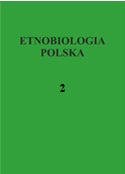Rdestowiec ostrokończysty (Reynoutria japonica Houtt.) – roślina użytkowana kulinarnie w Puszczy Białowieskiej
Słowa kluczowe:
invasive plants, children, wild food plants, wild edible plants, new uses, ethnobotanyAbstrakt
Japanese knotweed (Reynoutria japonica) is commonly used as a wild vegetable in Japan, Korea and North-East China. On Sakhalin Island and the Kuril Islands it has also been adopted by the Russian population, and used there differently than in Japan. The paper reports a case of the use of this feral invasive ornamental plant in Europe, in the Białowieża Forest. In the village of Budy people began using the plant in 1920. It is associated with changes of place of residence and restricted access to agricultural products. The use of the plant started with children experimenting by eating it and adding it to cakes, as it reminded them of rhubarb. Continuation of use depends on the commitment of the community to the tradition. The plant is still used by a few inhabitants of Budy and of the county town of Hajnówka.
Downloads
Bibliografia
Albertenst B, Böhmer HJ 2011. NOBANIS-Invasive Alien Species Fact Sheet-Fallopia Japonica. – From: Online Database of the European Network on Invasive Alien Species – NOBANIS www.nobanis.org Access date: 22.10.2012
Eui Taek Jeong, Mu Hyun Jin, Mi-Sun Kim, Yun Hee Chang, Sun Goo Park 2010. Inhibition of Melanogenesis by Piceid Isolated from Polygonum cuspidatum. Arch Pharm Res 33/9:1331-1338
Faliński JB (ed) 1968. Park Narodowy w Puszczy Białowieskiej. Państwowe Wydawnictwo Rolnicze i Leśne, Warszawa
Jin Sook Kim, Dae Sik Jang, Young Sook Kim, Junghyun Kim, Chan-Sik Kim 2012. Patent application title: Compositions and functional foods for treating and preventing obesity using Polygonum cuspidatum butanol fraction and ethyl acetate fraction
Łuczaj Ł 2008. Polska, Włochy, Japonia i Ameryka, czyli kilka kulturowych porównań dotyczących użytkowania kulinarnego dzikich roślin. In: Łuczaj Ł (ed) Materiały z konferencji „Dzikie rośliny jadalne – zapomniany potencjał przyrody”. Przemyśl-Bolestraszyce 13 września 2007r., Arboretum i Zakład Fizjografii w Bolestraszycach, Bolestraszyce, pp. 5-12
Łuczaj Ł 2011. Dziko rosnące rośliny jadalne użytkowane w Polsce od połowy XIX w. do czasów współczesnych. Etnobiologia Polska 1: 57-125
Łuczaj Ł, Kujawska M 2012. Botanist and their childhood memories: an underutilized expert source in ethnobotanical research. Botanical Journal of Linnean Society 168: 334-343
Łuczaj Ł, Szymański WM 2007. Wild vascular plants gathered for consumption in the Polish countryside: a review. Journal of Ethnobiology and Ethnomedicine 3: 3-17
Kimura Y , Okuda H 2001. Resveratrol Isolated from Polygonum cuspidatum Root Prevents Tumor Growth and Metastasis to Lung and Tumor-Induced Neovascularization in Lewis Lung Carcinoma-Bearing Mice. The Journal of Nutrion131(6): 1844-1849
Pirożnikow E 2010. Tradycja użytkowania roślin dziko rosnących na Podlasiu – poszukiwanie smaków, zdrowia i zaspokojenia głodu. In: Stolična R, Drożdż A (eds) “Historie kuchenne. Rola i znaczenie pożywienia w kulturze”. Uniwersytet Śląski w Katowicach, Cieszyn-Katowice-Brno, pp. 188-200
Spainhour J 2008. Medical Attributes of Polygonum cuspidatum – Japanese knotweed. klemow.wilkes.edu/Polygonum.html - 16k Access date: 22.10.2012
Stolična R 2010. O metodologii badań nad pożywieniem. In: Stolična R, Drożdż A (eds) „Historie kuchenne. Rola i znaczenie pożywienia w kulturze”. Uniwersytet Śląski Katowicach, Cieszyn-Katowice-Brno, pp. 8-14
Tokarska-Guzik B, Bzdęga K, Knapik D, Jenczała G 2006: Changes in plant species richness in some riparian plant communities as a result of their colonization by taxa of Reynoutria (Fallopia). BiodiversityResearch and Conservation 1-2: 123-130
Zarzycki K, Trzcińska-Tacikowa H, Różański W, Szeląg Z, Wołek J, Korzeniak U 2002.
Ecological indicator values of vascular plants of Poland. W. Szafer Institute of Botany, Polish Academy of Sciences, Kraków
Zou X, Huang F, Hao L, Zaho J, Mao H, Zhang J, Ren S 2010. The socio-economic importance of wild vegetable resources and their conservation: a case study from China. Kew Bulletin 65:577-582
Pobrania
Opublikowane
Jak cytować
Numer
Dział
Licencja
Prawa autorskie (c) 2012 Etnobiologia Polska

Utwór dostępny jest na licencji Creative Commons Uznanie autorstwa – Użycie niekomercyjne – Bez utworów zależnych 4.0 Międzynarodowe.


